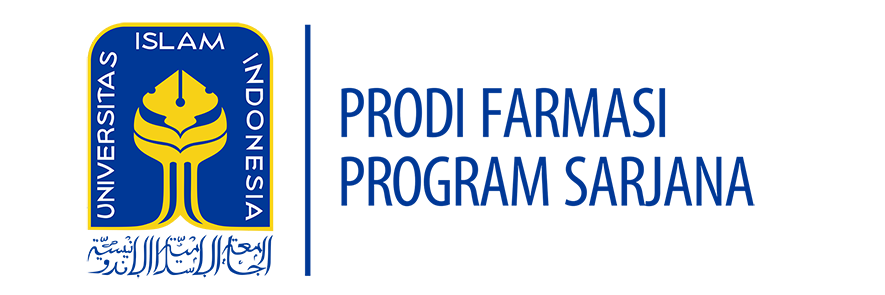| Module Name |
Practical on Aseptic Formulation and Technology |
| Module level, if applicable |
3rd year |
| Code, if applicable |
SFA-659 |
| Semester (s) in which the module is taught |
Sixth semester |
| Person responsible for the module |
Dr. apt. Lutfi Chabib, M.Sc. |
| Lecturer(s) |
Dr. apt. Lutfi Chabib, M.Sc. |
| Language |
English- Indonesia |
| Relation to curriculum |
Compulsory course |
| Types of teaching and learning |
Class size |
Attendance time (hours per week per semester) |
Forms of active participation |
Workload |
|
| Practical course |
30 |
3 |
Collaborative discussion |
Laboratory Practice 3 (hours) x 14 (meeting) |
42 |
| Collaborative Learning |
Collaborative Problem Solving |
| Total workload |
42 |
| ECTS |
1.5 ECTS |
| Credit points |
1 CU |
| Requirements according to examination regulations |
Minimum attendance at lectures is 75% (according to UII regulation). Final score is evaluated based on laboratory practices and reports (45%), discipline (15%), and exam (40%) |
| Recommended prerequisites |
Aseptic Formulation and Technology |
| Related course |
– |
| Module objectives/intended learning |
By the end of this course students should be able to:
- apply an attitude of responsibility, dedication, togetherness and discipline based on sincerity, honesty and integrity in the manufacture of solid preparations carefully and thoroughly.
- work together in groups
- preformulation, design and packaging of sterile preparations
- make sterile preparations
- carry out quality control of sterile preparations
|
| Content |
The course will cover:
- Preformulation of sterile preparations
- Sterile dosage formulation
- Manufacturing of sterile preparations
- Quality control of sterile preparations
- Technology and formulation of small and large volume injection preparations
- Technology and formulation of eye drops and eye ointments
- Technology and formulation of nasal drops and ear drops
|
| Study and examination requirements and forms of examination |
Worksheet assessment, quiz, assignment, and final exam |
| Media employed |
Text books, slides (power points), and video |
| Reading lists |
- Niazi, S. K. (2009). Handbook of pharmaceutical manufacturing formulations. CRC press.
- Akers, M. J. (2016). Sterile drug products: formulation, packaging, manufacturing and quality (Vol. 208). CRC Press.
|
Module Name
|
Practical on Aseptic Formulation and Technology |
| Module level, if applicable |
3rd year |
| Code, if applicable |
SFA-659 |
| Semester (s) in which the module is taught |
Sixth semester |
| Person responsible for the module |
Dr. apt. Lutfi Chabib, M.Sc. |
| Lecturer(s) |
Dr. apt. Lutfi Chabib, M.Sc. |
| Language |
English- Indonesia |
| Relation to curriculum |
Compulsory course |
| Types of teaching and learning |
Class size |
Attendance time (hours per week per semester) |
Forms of active participation |
Workload |
|
| Practical course |
30 |
3 |
Collaborative discussion |
Laboratory Practice 3 (hours) x 14 (meeting) |
42 |
| Collaborative Learning |
Collaborative Problem Solving |
| Total workload |
42 |
| Credit points |
1 CU |
| Requirements according to examination regulations |
Minimum attendance at lectures is 75% (according to UII regulation). Final score is evaluated based on laboratory practices and reports (45%), discipline (15%), and exam (40%) |
| Recommended prerequisites |
Aseptic Formulation and Technology |
| Related course |
– |
| Module objectives/intended learning |
By the end of this course students should be able to:
- apply an attitude of responsibility, dedication, togetherness and discipline based on sincerity, honesty and integrity in the manufacture of solid preparations carefully and thoroughly.
- work together in groups
- preformulation, design and packaging of sterile preparations
- make sterile preparations
- carry out quality control of sterile preparations
|
| Content |
The course will cover:
- Preformulation of sterile preparations
- Sterile dosage formulation
- Manufacturing of sterile preparations
- Quality control of sterile preparations
- Technology and formulation of small and large volume injection preparations
- Technology and formulation of eye drops and eye ointments
- Technology and formulation of nasal drops and ear drops
|
| Study and examination requirements and forms of examination |
Worksheet assessment, quiz, assignment, and final exam |
| Media employed |
Text books, slides (power points), and video |
| Reading lists |
- Niazi, S. K. (2009). Handbook of pharmaceutical manufacturing formulations. CRC press.
- Akers, M. J. (2016). Sterile drug products: formulation, packaging, manufacturing and quality (Vol. 208). CRC Press.
|
